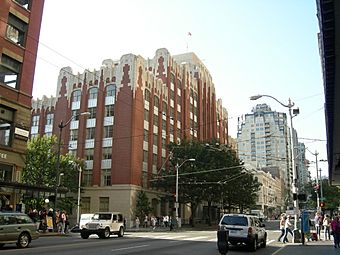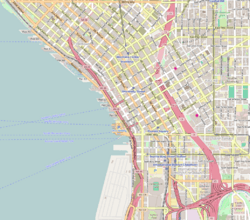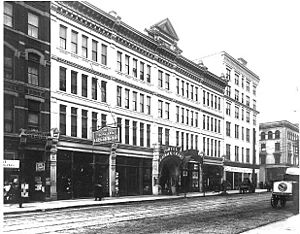Federal Office Building (Seattle) facts for kids
Quick facts for kids |
|
|
Federal Office Building
|
|

Old Federal Building, September 2007
|
|
| Location | 909 1st Ave., Seattle, Washington |
|---|---|
| Area | 1.2 acres (0.49 ha) |
| Built | 1932 |
| Architect | Office of the Supervising Architect under James A. Wetmore |
| Architectural style | Art Deco, Modernistic |
| NRHP reference No. | 79003155 |
| Added to NRHP | April 30, 1979 |
The Federal Office Building in Seattle, Washington, is a very old and important government building. It's located in Seattle, a big city in King County, Washington. This building has a rich history and a unique design.
Contents
History of the Federal Building
Early Days of Seattle
Local stories say that the Federal Office Building stands where Seattle's first leaders landed their boat. In 1851, A. A. Denny, William Bell, and C. D. Boren explored Puget Sound. They were looking for good places to build a city. By the late 1880s, this area had many small wooden shops and hotels.
The Great Seattle Fire
A huge fire started on June 6, 1889, right where the Federal Office Building is now. This fire, known as the Great Seattle Fire, destroyed over 64 acres (about 260,000 square meters) of the city's business area. After the fire, the city quickly rebuilt. Many new, taller buildings were constructed.
A New Government Building
In 1897, Seattle became very important for people heading to the Klondike Gold Rush in Alaska. The city grew fast, and the government needed a central place for its offices. In 1928, the U.S. Congress approved over $2 million to buy land and build a new federal building.
The building was designed between 1930 and 1931. The main architect was James A. Wetmore from the Office of the Supervising Architect. This building was one of the first federal buildings to use the Art Deco style. This was a new and modern look, different from older, more traditional styles.
Construction and First Uses
Construction finished in 1933. The Murch Construction Company from St. Louis, Missouri built it. The building used a lot of aluminum from factories near the Columbia River. It was the first building in Seattle made just for federal government offices. About 52 different government groups moved in, including the Department of the Treasury.
Today, the building is near other famous Seattle spots. These include Pioneer Square, Pike Place Market, and the waterfront. The Henry M. Jackson Federal Building was built across the street in the 1970s. In 1979, the Federal Office Building was added to the National Register of Historic Places. This means it's a very important historic site.
Building Design and Style
Art Deco Features
The Federal Office Building is a great example of Art Deco architecture. Art Deco was a popular style that started in the 1920s. It focuses on tall, vertical lines and lots of fancy, geometric decorations.
The building has a stepped shape. The outer parts are six to nine stories tall. The central tower reaches eleven stories high. The very top of the tower has a ziggurat shape, which looks like a stepped pyramid. A flagpole stands at its highest point.
Materials and Details
The building has a strong steel frame covered in concrete. This helps protect it from fire. It's also special because it used a lot of aluminum. Aluminum panels are placed between the windows on the third through sixth floors. These panels show symbols of different government groups or cool geometric designs. This was one of the first times so much aluminum was used on a building on the West Coast.
The bottom of the building sits on a strong granite base. The first floor is covered in smooth terracotta. Terracotta is a type of baked clay that looks like stone. The middle part of the building is made of light red brick. Fancy, stylized decorations made of pale terracotta are at the top.
Grand Entrance
The main entrance on the front has three doors. These are decorated with vertical pale terracotta designs. You can see tiny ram and lion heads. A stylized eagle design is right above the entrance. Bronze lanterns light up the area. Two large, five-foot-tall bronze urns stand next to the entrance. These urns were moved from the 1909 Alaska–Yukon–Pacific Exposition. They also have cool geometric patterns.
Even the back of the building is highly detailed. This is because the back faces Western Avenue, which is an important street. The building's cornerstone and two plaques about the Great Seattle Fire of 1889 are located near where the fire started.
Inside the Building
The public areas inside are also very decorated with Art Deco designs. When you enter from First Avenue, you go into a small entry area. It has bronze decorations and bronze-and-glass doors. These lead to the main lobby and the post office.
The lobby floor has dark red terracotta tiles. It also has strips and baseboards made of Tokeen marble from Alaska. The walls are covered in light gray Wilkeson sandstone. The ceiling is a coffered ceiling, meaning it has sunken panels. Some original bronze light fixtures, shaped like upside-down pyramids, are still in the lobby. There's also an elevator lobby with four elevators. Their original bronze doors have beautiful Art Deco flower designs.
At one end of the entry area is the U.S. Post Office. You enter through an opening with stained oak columns. The postal lobby looks almost the same as when the building was first built. It's one of the most important rooms inside. Two original postal service windows are made of stained oak. They have simple scroll designs and carved tops. The floor is shiny, dark red terracotta tile. Stained oak wood covers the lower part of the walls, about three feet high. Above this wood, the plaster walls have a rough texture. The ceiling has a curved molding with a fruit-and-leaf design.
Key Moments in History
- 1851: Seattle's founders landed on the site where the building now stands.
- 1889: The Great Seattle Fire began at this location.
- 1931-1933: The Federal Office Building was built.
- 1975-1976: The Jackson Federal Building was constructed across the street.
- 1979: The Federal Office Building was added to the National Register of Historic Places.
Building Facts
- Location: 909 First Avenue
- Architect: James A. Wetmore
- Built: 1931–1933
- Architectural Style: Art Deco
- Important Status: Listed in the National Register of Historic Places
- Main Materials: Red Brick and Terra Cotta
- Special Features: Central tower with a ziggurat top; many Art Deco decorations



